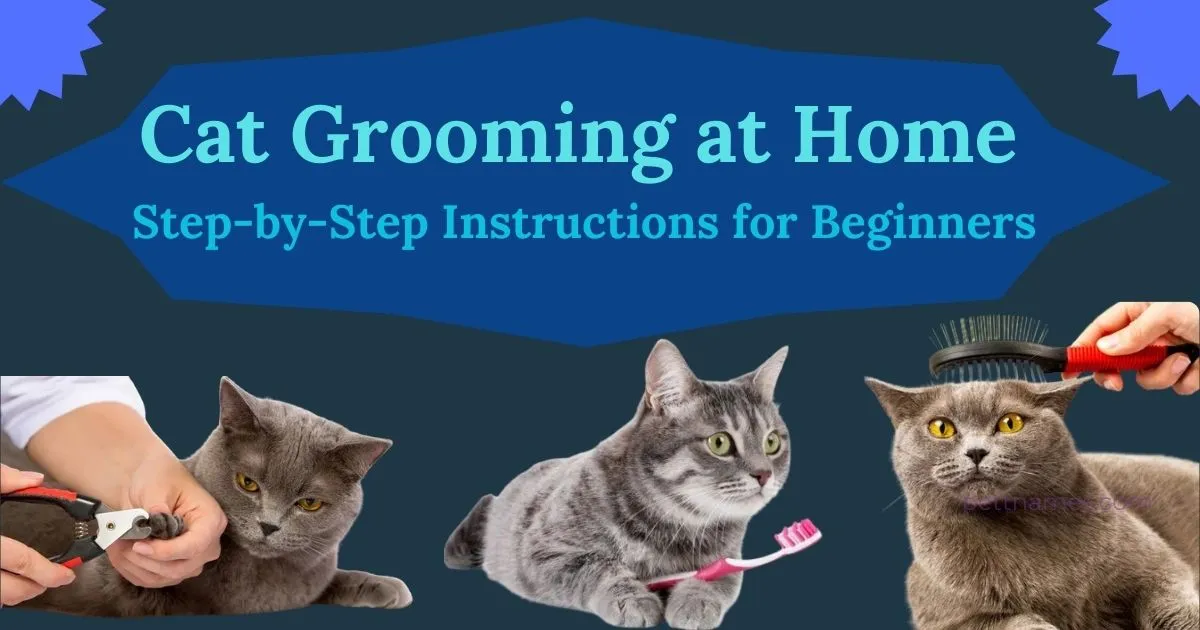Grooming your cat at home is not only a great way to keep your pet healthy and clean but also an opportunity to bond with your feline friend. Whether you have a long-haired Persian or a short-haired Tabby, grooming your cat regularly helps prevent mats, reduces shedding, and ensures their skin stays healthy. If you’re new to cat grooming, this guide provides a comprehensive, step-by-step approach to help you get started.
Why Groom Your Cat at Home?
Grooming your cat at home comes with a variety of benefits. Not only does it save you the expense of professional grooming services, but it also provides you with complete control over the process. Grooming can be an enjoyable and rewarding experience for both you and your cat.
Benefits of Home Grooming:
Saves money: Professional grooming can be costly, and grooming at home eliminates the need for these regular visits.
Healthier coat: Regular grooming keeps your cat’s coat shiny, healthy, and free from tangles or mats.
Prevents health issues: Grooming helps spot skin infections, parasites, or unusual lumps early on.
Stress reduction: Your cat will be more comfortable in their familiar home environment rather than a grooming salon.
When to Start Grooming Your Cat: It’s important to start grooming your cat from an early age. Begin when they are a kitten to help them get used to the process. Regular grooming should be part of your cat’s routine, with frequency depending on their breed and coat type.
Essential Tools for Cat Grooming at Home
Before diving into the step-by-step grooming process, it’s essential to gather the right tools to ensure an effective and comfortable grooming session for your cat.
Brushes and Combs
Choosing the right brush depends on the type of fur your cat has. For long-haired cats like Persians or Maine Coons, a slicker brush is ideal for detangling. For short-haired breeds like Siamese, a bristle brush works well for maintaining a smooth coat.
Best Brushes for Long-Haired Cats: Slicker brushes, wide-toothed combs
Best Brushes for Short-Haired Cats: Bristle brushes, rubber brushes
Nail Trimmers and Scissors
To keep your cat’s nails neat and prevent overgrowth, nail trimming is an essential part of grooming. Use cat-specific nail trimmers for accuracy and safety.
How to Choose the Right Nail Trimmer: Opt for a scissor-style trimmer or a guillotine trimmer designed specifically for cats.
Shampoos and Conditioners for Cats
Select cat-specific shampoos for bathing your pet. Regular human shampoos can irritate a cat’s skin, so ensure that your products are made for feline skin.
Choosing the Right Shampoo: Use natural, hypoallergenic, or medicated shampoos based on your cat’s skin condition.
Additional Grooming Tools
Consider adding grooming gloves or cat wipes to your toolkit for quick clean-ups in between full grooming sessions. These tools are excellent for cats who are not fond of traditional brushes.
Step-by-Step Guide to Grooming Your Cat at Home

Now that you have all the tools you need, let’s dive into the step-by-step process of grooming your cat at home. Whether your cat loves the grooming process or it’s a bit of a challenge, these simple steps will help you make it a smooth experience.
Step 1: Preparing Your Cat for Grooming
Before beginning any grooming session, it’s important to prepare your cat to reduce anxiety and ensure they’re comfortable.
Setting Up a Calm Environment: Choose a quiet space in your home where you and your cat can focus. Dim the lights, play calming music, and avoid any distractions.
How to Calm an Anxious Cat: If your cat is nervous, try pheromone sprays to help calm them. Gently petting your cat and offering a treat beforehand will help ease their nerves.
Step 2: Brushing Your Cat’s Coat
The first step in grooming is always brushing. This not only removes loose fur but also helps prevent matting and tangling, especially for long-haired breeds.
Brushing Long-Haired Cats: Divide your cat’s fur into sections and use a slicker brush or wide-toothed comb to gently work through tangles. Always brush in the direction of hair growth to avoid discomfort.
Brushing Short-Haired Cats: Use a bristle brush to maintain their coat and remove loose fur. Short-haired cats can benefit from brushing once or twice a week.
Step 3: Bathing Your Cat
Some cats may need occasional baths, particularly if they’ve rolled in something sticky or smelly. Bathing should be done sparingly, as cats generally do a great job of grooming themselves.
Preparing for the Bath: Fill a small tub or sink with lukewarm water, just enough to wet your cat’s body. Have cat shampoo ready.
How to Bathe Your Cat Gently: Wet your cat’s fur with a cup of water, avoiding the head. Apply a small amount of shampoo and gently massage it into their fur. Rinse thoroughly, making sure no shampoo residue remains.
Step 4: Trimming Your Cat’s Nails
Trimming your cat’s nails is essential for preventing overgrowth and ensuring they don’t snag on furniture or carpets.
How to Safely Trim Cat Nails: Hold your cat’s paw gently and press their pad to expose the claws. Use nail trimmers to cut off the sharp tips. Be careful to avoid cutting into the quick, the pink area inside the nail.
Step 5: Cleaning Your Cat’s Ears and Eyes
Keep your cat’s ears and eyes clean to prevent infections. Some cats are prone to eye discharge, especially those with flat faces like Persians or Exotic Shorthairs.
How to Clean Cat Ears Safely: Use a cotton ball or gauze with a gentle ear cleaner to wipe the inside of your cat’s ears. Avoid inserting anything deep into the ear canal.
Cleaning the Eyes Gently: Use a damp cotton ball to wipe away eye discharge. If your cat has chronic eye issues, consider consulting your vet for advice on proper cleaning methods.
You may also like:
Top Cat Grooming Tips for a Healthy, Happy Pet
Common Mistakes to Avoid When Cat Grooming at Home
While grooming your cat is a great bonding activity, there are some common mistakes you’ll want to avoid to ensure your cat’s comfort and safety.
Over-Brushing or Pulling Fur
Brushing your cat too aggressively can cause discomfort or pain. Always use gentle strokes and avoid pulling on tangled fur. Take breaks if your cat seems uncomfortable.
Not Using the Right Products for Your Cat’s Coat
Using human grooming products or harsh chemicals can irritate your cat’s skin. Always opt for cat-specific grooming products to ensure their safety.
Stressing Your Cat During Grooming
If your cat shows signs of stress—like growling, scratching, or trying to escape—take a break and try again later. Start with short grooming sessions and gradually increase the time as your cat gets more comfortable.
Cat Grooming Tips for Beginners
Grooming a Cat with Special Needs
Some cats have special grooming needs, such as those with sensitive skin, older cats, or cats with health conditions.
Cats with Sensitive Skin: Use hypoallergenic products to avoid irritation.
Senior Cats: Older cats may have stiff joints or arthritis. Use gentle techniques and keep grooming sessions short.
How to Make Grooming a Positive Experience
Make grooming a positive experience by rewarding your cat with treats and praise after each session. This helps them associate grooming with something enjoyable.
Frequently Asked Questions About Cat Grooming at Home
How Often Should You Groom Your Cat?
The frequency of grooming depends on your cat’s breed and coat type. Long-haired cats need daily brushing, while short-haired cats can be groomed once a week.
Can I Groom My Cat If They Are Not Used to It?
Yes! Start slowly and gently. Introduce your cat to grooming with short sessions and lots of praise and treats.
What If My Cat Doesn’t Like Being Groomed?
If your cat is very resistant, try gradual desensitization. Start by touching their paws, ears, and body without grooming tools, then slowly introduce the tools. If your cat remains stressed, consider professional grooming services.
Conclusion: Cat Grooming at Home
Grooming your cat at home is a rewarding and bonding experience that contributes to your cat’s health and well-being. With the right tools, patience, and knowledge, you can confidently groom your cat and keep them looking and feeling their best. Start with short sessions and build up to longer grooming times as your cat becomes more comfortable. Your cat will appreciate the care and attention, and you’ll enjoy a cleaner, healthier pet!
Call to Action:Cat Grooming at Home
Ready to start grooming your cat at home? Gather your grooming tools, follow these simple steps, and enjoy quality time with your furry friend! Share your grooming tips in the comments below.
Thank You for Visit, For more posts please visit to our website pettnames.com
Read also:



